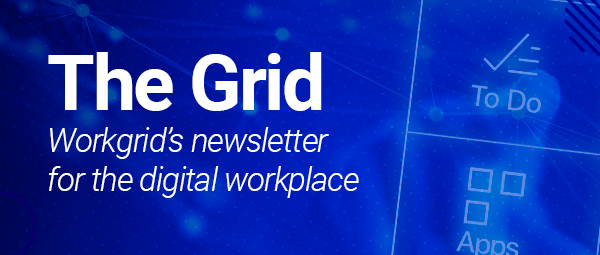In the early 2000s, Liberty Mutual's "digital workplace" functioned much like that of any other large organization. Email was the primary method of communication, Novell and Windows NT file shares were the main collaboration tools and the entire organization was supported by monolithic ERP systems that chugged along behind the scenes and kept the whole enterprise running.
Fast-forward to the 2010s, however, and the modern concept of a digital workplace was really starting to take hold. Liberty was very focused on creating a cutting-edge work environment, which involved digitizing employee tools and information and bringing in new capabilities around mobile, social and collaboration.
Ultimately, the organization was transitioning from the massive ERP solutions we'd historically relied on to a more agile conglomeration of pointed solutions. It was an evolution that was being undertaken by many organizations at the time, but unfortunately, it was also one that was creating unforeseen challenges for the Liberty workforce.
Identifying and understanding digital workplace challenges
As Liberty Mutual was rolling out the typical systems you'd see in an organization - travel, procurement, IT service management, even systems to manage systems - we were inadvertently creating a very splintered experience for employees.
![[asset] Workplace Complexity](https://images.ctfassets.net/z7p73u8c0thn/4YOsYtJke4TV9qiuEpy6ir/d4f231a7bcc7beb9355d2d09d2b9cf2c/WorkplaceComplexity.jfif?w=1200&h=527&fl=progressive&q=60&fm=jpg&bg=transparent)
The complexity of today's digital workplace is a constant strain on the digital employee experience.
What we found is that Liberty wasn't the only company facing these challenges. In fact, most organizations at the time that were investing in technology to streamline the workplace -- but, despite the best of intentions, the results of those improvement initiatives were counterproductive:
65% of employees were putting off certain work because it was so time consuming to have to interact with so many different systems (Forrester)
This was simply not good enough for our employees, so we began the journey of delivering a modern, integrated view of enterprise applications to simplify employees' day-to-day experience. We started by talking with employees -- what better way to make their lives easier and free them for higher value work and personal connections than by first understanding their challenges?
![[asset] Office Workplace Stock Photo](https://images.ctfassets.net/z7p73u8c0thn/7MurW2gCUzAVbSJJz3NHGk/60092a9fbf917148ee4084bf532136ff/workplace-1245776.jpg?w=1200&h=800&fl=progressive&q=60&fm=jpg&bg=transparent)
Understanding employees' needs is the first step in building a successful digital employee experience.
What we learned when we spoke with them was understandable. No one likes feeling as though they're missing important information because there's so much going on and having to log into multiple systems to complete simply, yet necessary tasks isn't ideal either. Our employees were experiencing both of those challenges.
Things simply could not continue as they were -- we needed to address the situation. Employees have a choice about where they work, so if we were going to attract and retain top talent, we needed to develop a best-in-class digital workplace experience that puts the most important tasks, information, and notifications at employees' fingertips. But how?
Solving digital workplace challenges
Having identified the challenges our employees were facing, our goals became clear. We needed to create a simple, intuitive and contextual experience -- one that would help employees easily consume relevant communications from across the organizations and complete necessary tasks.
This realization came in part from an insight voiced by NYU professor Clay Shirky, "It's not information overload, it's filter failure."
![[asset] Clay Shirky Quote](https://images.ctfassets.net/z7p73u8c0thn/6NeqzkzIAj2FYVbFHIXnZt/bb9088fd573e41f3492e48d7c56c9203/Clay_Shirky_Quote.png?w=780&h=227&q=60&fm=png&bg=transparent)
The ideal digital workplace helps employees minimizing the cognitive overload that comes from having too many sources of information to pay attention to. (Source)
Since there was nothing we could do to minimize the amount of information employees had to process, we chose to create a solution that would intelligently filter that information and make it easy for staff to tell at a glance what required their immediate attention.
As we focused on our aspiration of consolidating dozens of separate sources of information into a single digital hub, there were a few issues that we knew would be of critical importance:
The design of the solution had to be approached differently -- these issues wouldn't be solved by finding an out-of-the-box piece of software that we could immediately plug and play.
To be successful we'd have to go back to employees and compile the hundreds of different use cases we'd need to create an experience that worked for everyone.
Action was key. Lean and agile development principles would be required so we could quickly cycle through learning and improvement phases.
Future-proofing the solution had to be a priority. With things like Google glass, augmented reality and wearables gaining varying degrees of traction in the consumer industry, we had to be prepared for future trends and create a platform that would grow with our needs (APIs would be key to this endeavor)
We had to focus on outcome driven development as we thought about how to simplify processes. Common tasks had to be pared down to fewer steps (e.g. requesting time off should only be a single step, rather than one step to schedule time with an HR system, one step to notify the team, one step to block the time on your calendar, one step to set up an out of office message, etc.).
Keeping all of this in mind, we set to work creating the ultimate experience for employees that would be a help and not a hindrance. It was by no means an overnight process, but over the course of 12-18 months, we had a solution (which we'd named the "Workgrid Assistant") that performed exactly as we needed it to -- a solution that is still evolving today as we strive to create consistent, increasing value for employees.
![[asset] liberty-architecture-workgrid-assistant](https://images.ctfassets.net/z7p73u8c0thn/4FRvIU3GAXiqUYrv5248Kd/eabd61e65cde53713ba5c5cffdcf5218/liberty-architecture-workgrid-assistant.png?w=750&h=400&q=60&fm=png&bg=transparent)
The Workgrid Assistant helped create a modern digital workplace that gave employees a centralized location for the tasks and information they needed the most.
With a variety of channels including an Intranet web client, toolbar, browser extension, and Microsoft Teams integration, the Workgrid Assistant acts as an individualized personal assistant for each employee, seamlessly abstracting important data from foundational systems and presenting it in a single location. At its core, it works by detecting events and then delivering notifications and tasks directly to the employee. Information is also available on a "pull" basis through a chatbot employees can use to ask questions. For a complete run down of the development process and functionality that was built, check out the session I delivered at the Gartner Digital Workplace Summit.
Achieving digital workplace and employee experience goals
Ultimately, the Workgrid Assistant accomplished all of Liberty's goals. From a tactical perspective, it managed complexity by creating a central hub of information, eliminating the need for employees to log into multiple back-end tools to complete necessary administrative tasks, plus it elevated communications outside of email so things couldn't be overlooked. The bigger impact of the system was the most important, however. There's no questioning that employees and their time are a company's most precious assets. By building a solution that saves them time -- while providing a user experience they have come to expect as consumers -- we drove significant efficiencies and cost savings while increasing employee engagement and improving retention.
![[asset] LM-Digital-Assistant-Intranet-Example](https://images.ctfassets.net/z7p73u8c0thn/4nToA2rVlrrGCw8lszddiI/01540c57805727b2d1d18f09891f951d/LM_example.png?w=1200&h=616&q=60&fm=png&bg=transparent)
The overall benefits we realized after implementing the Workgrid Assistant were significant.
Benefits
Once the Workgrid Assistant went live, employees responded in ways that are not typically associated with enterprise software applications:
"Love it! Makes it so easy to see FTO hours"-- Lindsay, Business Analyst
"This is fantastic! One of the most useful tools I've seen in a long time."-- Jordan, Business Analyst
"This is all kinds of awesome. Thank you!"-- Gayle, Sr. Training Specialist
People's enthusiasm over the platform was great validation of all the work we had done to incorporate design thinking and create the kind of consumer-like experience employees had grown accustomed to in their personal lives.
Aside from some main benefits we had expected to see, like a drastically simplified user experience and a significant reduction in clicks needed to complete tasks, there were also a few we couldn't have predicted.
For example, internal communications saw a significant boost as employees clicked through messages 40% more than they had previously (internal communications is now a heavy stakeholder in the project). The Workgrid Assistant also reduced the impact of system migrations because the platform is an experience layer built on top of the Intranet. When major back-end systems were switched, like when Liberty moved from an on-premise system to the cloud, most employees didn't even notice the change because their experience was entirely driven through the Workgrid Assistant.
![[asset] evolving-the-digital-workplace-LM](https://images.ctfassets.net/z7p73u8c0thn/1trC4jjqH1DxkCrXsUaW7i/5a1ad2ac957f7c5858929c210af9a771/evolving-the-digital-workplace-03.png?w=785&h=493&q=60&fm=png&bg=transparent)
The implementation of the Workgrid Assistant led to significant employee experience benefits, including a modern intranet experience that served as the cornerstone of the digital workplace.
Ultimately, the benefits of the Workgrid Assistant added up to an award-winning employee experience, the importance of which cannot be understated. Employee experience is tied directly to customer experience, and that has a significant impact on bottom line revenue.
Lessons learned
Fueled with little more than a vision (and the tremendously appreciated support of the senior leadership team at Liberty), we created a solution that solved major pain points for more than 50,000 global employees. It was a process that left us a lot wiser than when we started, with five key lessons learned:
For an employee experience to be superior, it must be:
Consumer-like
Mobile-enabled
Personalized
The key to success is building the solution as a "digital experience layer," which is a layer that abstracts info from the best-of-breed systems the organization needs without forcing employees to deal with all the complexity that entails.
Having a digital experience layer that's 100% API-focused will future-proof your organization for whatever technology you might want to integrate next, such as voice.
Don't try to build this type of functionality into an IT Service Management platform or an HR tool. It will likely apart once you try to add interoperability with other systems. Instead, use a system that's separate from your systems of record. Doing so will also be helpful if you ever swap out a system of record -- then you won't lose your experience layer along with that change.
The Intranet is a great place to integrate a digital assistant. While we could have integrated the Workgrid Assistant with any commonly used application, the intranet was ultimately the best place to center our digital workplace strategy around.
For one thing, it meant employees didn't have an additional place to go to get information. Plus, our Intranet was a high traffic location. Given the number of employees already visiting the page, it was an ideal spot to help maximize adoption, which was key to the success of the initiative.
It's also important to note that while the tool looks and acts like an integrated part of the intranet, it isn't. That's important for two reasons --one, keeping the Workgrid Assistant separate from the intranet meant that no changes needed to be made to the intranet; secondly, the Workgrid Assistant would never be impacted if we decided to change the intranet down the road.
Armed with these lessons and a Workgrid Assistant that enables employees to be highly effective in their roles, Liberty is ideally positioned for the future of work, which is good, because the future is already here.
Looking Forward to the AI Assistant
From it's original inception with Liberty Mutual Insurance, the Workgrid Assistant has evolved to incorporate changing digital workplace technologies. Today the assistant leverages AI-powered functionality to deliver smarter, faster answers to employee queries while still providing the system-based alerts and tasks that help employees get work done.




